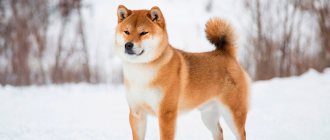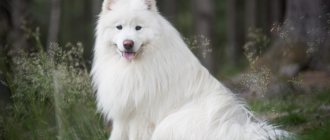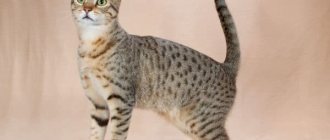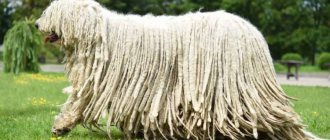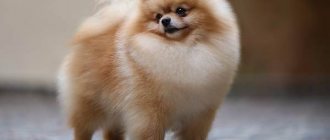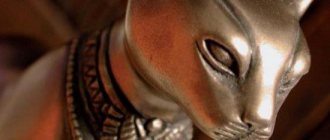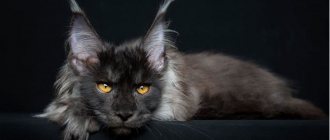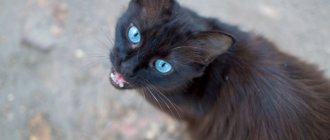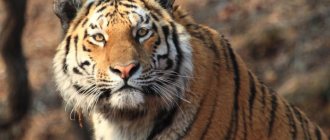What will you learn from the article?
- Shorthair cats with photos and names. European group.
- Oriental smooth-haired cat breeds Egyptian Mau
Short-haired cats are the great-great-great-great...grandmothers of your Murka. In fact, even if your pet has long hair that makes it impossible to see its graceful anatomy, the furry family tree begins with the Libyan dun cat. Almost 10,000 years ago, the Libyan dun cat (also known as the Nubian cat, also known as the North African steppe cat), noticing in its field of vision funny creatures so greedy for simple affection, decided to tame these creatures.
It must be said that the years of training were not in vain; if a person does not deify a cat, then at least he adores it, cares for it, feeds it, and at the same time cannot even rationally explain why he does this?! A fickle, capricious and independent cat simply allows itself to be loved, giving a person the opportunity to admire itself and from time to time to stroke its beautiful self (but not against the grain!)
The Nubian cat gene turned out to be so strong that today short-haired cats (both domestic and wild) are more common than cats with long hair. The dominance of the shorthair gene is easy to explain - a cat with short hair is naturally more independent than its long-haired sister. After all, such fur clings less to surrounding objects, it is also easier to catch parasites in it, and skin diseases bypass such cats.
So, Mother Nature and the miracles of selection provided shorthaired cats with first place in the number of breeds with this trait.
By the way, what distinguishes short-haired purrs from all other breeds is not only the length of their hairs, but also their quality!
Globally, experts divide shorthair cat breeds into the following groups:
- European
- eastern
- American
British cat
Representatives of this short-haired breed are becoming increasingly popular every year.
The massive build and expressive yellow-orange look give the representatives of the breed a special sophistication. The coat, as well as the undercoat, is quite thick. The character of cats is phlegmatic.
It is important to teach kittens to interact with people from an early age. Otherwise, an adult cat will avoid people and lead an isolated lifestyle.
Abyssinian breed
Representatives of the Abyssinian breed have an average build size.
The muscles of animals are well developed. This breed has a special grace. The long limbs of pets and their expressive eyes especially attract attention. Despite the apparent wildness in her gaze, the cat is different:
- flexible character;
- poise;
- affectionateness;
- curiosity;
- playfulness.
Animals do not like to be alone for long periods of time. Representatives of the breed can easily get along with another cat, dog and even small children.
Unrecognized breeds of shorthair cats
In order for a breed to be registered in felinological systems, four generations of stable individuals must be born, numerous exhibitions must be held, and its standard must be written and accepted by leading experts.
Many lines are initially approved as "experimental". Thus, four generations of many hybrid cats have not yet been obtained, but these breeds already exist, for example, Caracat.
There are also cats in the world that are considered unrecognized today. Work on selection is either currently underway or has been postponed for one reason or another. Some of them are very interesting.
Aegean
Ancient natural species from the Cyclades Islands in the Aegean Sea. Carefully cultivated by Greek breeders, but practically unknown outside its homeland.
About Aegean cats on our website.
Dutch Rex
Amazing kittens with coarse, curly hair were born to purebred Maine Coons in Holland in 1985. For now, selection has been suspended, but cases of the birth of such babies are periodically recorded by breeders.
Cats of Saint Helena
This is a natural view from the island of Cyprus. Two types are defined: St. Helena and Aphrodite. According to legend, these animals came to the island during difficult times of famine and drought on the orders of Empress Helena, mother of Constantine the Great, ruler of Jerusalem, to fight snakes.
Cohona
“Naked, naked” is how the name of the breed is translated from the Hawaiian language. The cat was born completely bald as a result of a natural mutation. Currently, about fifty of these individuals are registered.
Likoy
Strange kittens were born in 2010 in Virginia as a result of a natural genetic mutation. Sparse hair, complete absence of undercoat, hairless ears and roan coloring do not make these animals particularly cute. But the kids have a wonderful character.
They got their name because of their resemblance to the werewolf of the same name from horror films. Translated from Greek it means “wolf”.
Bambob
Obtained in the United States of America by crossing the Bambino and the American Bobtail and Sphynx mix. In addition to a bald body and short legs, it also has a small tail (tailless). Work on the breed continues.
Bramble
Obtained in the USA by crossing Bengal and Peterbald. Currently registered in the register of exotic and rare breeds.
Bristol
A hybrid of the very rare wild Margay (long-tailed cat) and the American Shorthair. They are very few in number, so they are still considered an experimental breed.
Dwelf
Bald dwarfs with curled ears, like curls. The result of crossing a Munchkin, a Sphinx and an American Curl.
Anatolian cat
According to the breed standard, the body of representatives of the Anatolian breed should be large with well-developed muscles.
The massive neck and chest look wide. Anatolian cats practically do not meow, making sounds that imitate the chirping of chicks when necessary.
Animals love to play with pieces of paper tied to a string. The nature of the pets is calm and balanced, which makes it possible for families who already have pets to have cats.
Character and temperament
The variety of characters of domestic shorthair cats matches the variety of their external characteristics. Since the pedigree of such cats is completely unknown, and they breed randomly, it is completely impossible to predict what the kitten will be like when it grows up. He can be quiet and very talkative, large or small, nimble or calm, a walker or a homebody. In contrast, purebred cats have specially cultivated certain character traits and therefore their behavior is quite predictable.
In general, a short-haired cat can be said to be more temperamental than its long-haired relatives. If it is possible to see the kitten's parents, which is actually quite difficult, this could give you a general idea of what the kitten will be like when it grows up. And do not forget that character is very dependent on early socialization and care of the kitten . If you need a loyal friend, then spend a lot of time with your pet.
Bengal cat
According to the breed standard, the body of Bengals is elongated. The muscles are well developed, and the paws look quite strong. The tip of the tail is colored black. The eyes of the representatives of the breed are expressive, and the ears are quite widely spaced. Bengal cats are enough:
- friendly;
- active;
- playful;
- inquisitive;
- sociable;
- affectionate.
For a long time, pets can play with children and other pets living in the family.
Representatives of the breed are easy to train.
Egyptian Mau
According to the characteristics of the breed, the Egyptian Mau is distinguished by grace and sophistication.
Looking at photos of cats, it can be noted that the patterns on a cat’s fur add sophistication to a cat’s. Representatives of the breed love to be the center of attention. You can look at cats for hours, admiring their beauty, grace and elegant movement.
The Egyptian Mau cannot be alone for long. If the owners often leave the cat alone, the animal may play pranks at home in protest. Don't scold your pet. It is better to organize your life in such a way that during departures, one of your relatives is at home with the cat.
A mischievous and playful pet needs frequent walks in the fresh air and outdoor games with an artificial mouse tied to a string.
Care Tips
Smooth-haired cats are not very picky.
- It is enough to comb them once a week, and to maintain the coat in good condition, you can use a special conditioner.
- Curly-haired cats should not be bathed too often, and immediately after water procedures they should not be combed.
- A suede cloth is suitable for smoothing hairs.
- As for plush cats, remove dead hair once or twice a week using a rubber brush or a special silicone glove.
Korat
Korats are very energetic, loving, intelligent and jealous.
Unfortunately, cats cannot come to terms with the presence of other animals in the family, constantly showing their superiority. Delicate pets move with virtually no noise. Cats do not like loud noise and will always leave a room where people are listening to music or talking in a loud voice.
At the same time, the Korats treat small children with love. When playing, they play with them carefully and do not scratch them.
Korats choose one owner in the family.
Features of caring for short-haired cats
Caring for short-haired cats is very easy. Absent or minimal human intervention in the formation of the breed makes such animals healthy and hardy.
Of course, there are breeds that are more prone than others to certain hereditary pathologies (for example, the Scottish Fold is characterized by osteochondrodysplasia, that is, improper development of bones and cartilage tissue, it is this defect that causes sagging ears), but these diseases are in no way related to the length of the coat .
The floppy ears of the Scottish Fold are the result of congenital problems with cartilaginous tissue.
By and large, the short hair of pets does not require special care. However, this does not mean that such cats do not shed! The amount of fluff flying around the house where a cat lives does not depend on the length of its fur (the only difference is the length of the hairs that settle on the furniture). Therefore, animals with short hair can and even need to be combed, it’s just that this procedure has slightly different goals.
Short-haired cats shed just as much as long-haired cats.
Brushing a long-haired cat is necessary for the health of the animal itself. Ungroomed fur gets tangled and becomes a real breeding ground for parasites. In addition, regular licking of long hair is fraught with gum inflammation and even intestinal blockage.
Swallowed fur forms clumps in the cat's stomach and can clog the intestines.
With short hair, no matter what overly active enthusiasts say, a cat is quite capable of coping on its own. But periodic combing allows you to remove dead hairs in a timely manner, thus reducing their spread throughout the house. A light massage is also beneficial for the animal’s skin, improves blood circulation in it and strengthens the coat, preventing excessive hair loss. Finally, many cats experience great pleasure from brushing, so it can be a good opportunity for emotional intimacy between pet and owner.
Many cats love brushing
In conclusion, a few more words about molting. In the wild, cats usually change their coat twice a year: by winter the animal grows a thick undercoat, and in the spring, on the contrary, it changes its coat to a lighter one. However, in domestic cats forced to spend the winter in a warm and dry room, these processes become disrupted over time, and as a result, molting can turn into a sluggish, ongoing process. There is nothing wrong with this (however, providing cool and moist air in the apartment in winter is useful not only for the cat, but also for other household members).
Spending the entire winter on the battery, the cat loses the sense of the seasons and begins to shed constantly
At the same time, excessive shedding can be a warning sign. Intense hair loss often accompanies various diseases (both skin and internal organs), as well as problems with the emotional state of the animal.
Excessive shedding may be a result of stress.
My Thai cat lost hair in huge quantities in the last years of her life. Neither combing, nor even vacuuming, which the beast really liked, solved the problem: the hair simply did not stick to the poor old woman’s skin. But with the young Abyssinian it was more interesting. She loved my daughter so much that when she left, she literally began to shed her fur. When trying to pet the animal, tufts of zone-colored hairs remained in the hands. But as soon as the daughter returned, the painful molting miraculously stopped right before our eyes.
Cats always shed a lot when they get old.
Thus, by the quality of the coat you can always judge the physical and psychological state of the cat. It is not without reason that when preparing breeding animals for exhibitions, special attention is paid to the wool: it is washed, combed, fluffed, polished, etc. in a special way. If your pet is constantly losing its hair, you should definitely take a closer look at it: perhaps the animal is sick or something upset, scared. But if the animal is active and cheerful, and hair loss is minor, there is nothing to worry about. Brushing is not a mandatory part of caring for short-haired cats and remains at the complete discretion of the parties - the cat itself and its owner.
I also cannot help but note that non-shedding hairless cats are not at all a convenient replacement for “wool” cats. The unnatural absence of hair creates such problems for both the pet itself and its owner that shedding may seem like a mere trifle in comparison. By the way, the current opinion that hairless cats are hypoallergenic has nothing to do with reality.
Sphynx cats don't shed, but they create many other problems.
The conclusion suggests itself. You can talk about the pros and cons of long-haired or hairless cats, but the average length of hair has no disadvantages.
Minskin
According to the standard for small shorthaired cat breeds, the appearance of the Minskin should include:
- elongation of the body;
- developed muscles;
- wide, but at the same time short muzzle;
- wide ears, which are located at a great distance from each other;
- wide-set, oval-shaped eyes.
Representatives of the breed are curious, intelligent and quick-witted. They are easy to train if you start the process at an early age. Cats need their owner's attention. They will happily accompany him everywhere and watch his actions and mood changes. Minskin is able to get along not only with other cats, but even with a rodent and a dog.
To avoid health problems, you should feed your pet only high-quality food.
History and modernity of the shorthair cat
Cats are perhaps the most mysterious animals domesticated by humans. They have been living next to us for at least ten thousand years - around then the factor of artificial selection joined the natural evolution of species. People, according to their needs and tastes, began to form different cat populations in individual territories, improving, as they needed, the natural qualities of cats and using genetic mutations.
One of the six hundred cat statues found in the Temple of Bast in Alexandria
When a person began to lead a sedentary lifestyle, engage in farming and stockpile food, he needed an assistant to fight rodents encroaching on the crop. Scientists believe that various wild animals were used for this purpose, for example, genets or representatives of mustelids - ferrets. But cats, thanks to their intelligence and good human orientation, have pushed all competitors far away.
Scientists have conducted large-scale DNA studies of domestic cats from around the world, and based on data from almost a thousand pets, they have established that all modern “murks” have a common ancestor - the steppe cat. This wild species is widespread on the planet and is called Felis silvestris lybica in Latin. The animal with short striped hair, domesticated at least ten thousand years ago, gave rise to the entire variety of modern breeds.
The steppe cat, the progenitor of the domestic cat, still lives in the wild
Surely there were attempts to domesticate other species of the cat family - but they were not so successful. This, for example, is evidenced by recent finds by archaeologists in Central China. The remains of domestic cats found here date back to approximately the 4th millennium BC and have different genetics. It is assumed that the Chinese tried to domesticate Prionailurus bengalensis, a Bengal cat, but this experiment was not widespread.
Features of domestic cats with short hair
The broad concept of short-haired cats includes breeds whose fur length does not exceed 2.5 cm along the body and may be slightly longer in some areas, such as the tail. Cat fur varies significantly in texture - here we can distinguish the following options:
- short with a predominance of awns (Thai cat);
- short with developed undercoat (chartreuse);
- short hard (American shorthair cat);
- short wavy (Rex breed group);
- short smooth (Bombay cat);
- short without undercoat (oriental);
- hair of “hairless” cats (a group of sphinxes and breeds derived from them).
There are a lot of cat breeds - there are plenty to choose from to suit your taste and color
Sphynxes are also short-haired cats (with the exception of homozygous individuals), they have a soft, often almost invisible downy coat, which becomes longer in the cold season.
German Rex
The German Rex can become a real four-legged friend for any person. Cats of this breed are different:
- correctness;
- obedience;
- friendliness;
- playfulness;
- calmness, which often borders on laziness;
- patience turning into endurance.
The body type of the German Rex is proportionally built. The paws are quite high and thin. The coat can be colored in any color, but according to the breed standard it must be a single color. Any combination with white is acceptable. The silky coat does not contain any hard outer hairs.
Russian blue cat
The color of the coat of Russian Blue cats can be exclusively gray with a bluish tint.
In the sun, wool can shimmer with silvery notes. The large eyes are colored emerald green. According to the breed standard, the head is wedge-shaped and the ears are pointed. The physique of the Russian Blue cat is thin, but at the same time muscularity is emphasized.
The advantage of this breed is their intelligence, independence and caution. Cats do not really like guests, but they adore the company of their owner. Cats belonging to the short-haired category love to play ball. Often such a game brings them closer to the dogs that live in the family.
Russian Blue cats are sensitive to the toilet. They will never go into a dirty litter box.
Thai cat or traditional Siamese cat
Thai cats are similar in appearance to Siamese cats. A typical Thai cat has a round head, almond-shaped blue eyes, small ears, and a muscular body shape. Their color is point.
The tail, muzzle, tips of the ears and paws are painted with this color. The general description of the breed also fits the standard of Siamese cats of the 18th and 19th centuries. Due to their friendly and sociable temperament, these cats love to play and be pampered with their owner.
In addition to exotic beauty, they are also considered to have high intelligence potential. Brought to England, there were even legends about Thai cats associated with Buddhist monasteries. Cats, with eyes reflecting like the sky, and princesses who hung their rings on their arched tails.
The owners of such cats were servants at the temples of ancient Thailand. And the oriental gait of Thai seals was significantly different from the usual walking of their European and British counterparts.
Savannah
The Savannah's physique is muscular and elongated.
The neck is quite flexible and the legs are long. Thanks to their elongated limbs, representatives of such a large breed have the ability to jump to a height of more than 280 cm. The short coat of the animal is covered with various spots that resemble the skin of a leopard.
Such animals should not be brought into a family with small children. During play, the savannah will bite and scratch the baby vigorously. It is also not recommended to buy cat food if rodents and small cats live in the house.
Exotic Shorthair
The physique of exotics is massive and muscular.
The chest of the animals is quite wide, the paws are powerful, but squat. The highlight of the breed is its small upturned nose and huge cheeks. Small ears stick out forward. The good-natured nature of exotics allows even families with other pets to have animals.
Representatives of the breed captivate with their tenderness and affection. Exotic shorthair cats love not only to lie on the couch with their owner, but also to play outdoor games. A candy wrapper tied to a string will become a favorite pastime and will give many pleasant moments to the owner of the exotic.
The abundance of short-haired cat breeds allows each person to choose the animal that best suits their character. The information presented in the article regarding character traits will help you not make a mistake when choosing.
Main recognized breeds of shorthair cats
The first specialized exhibition was held in England in 1871. This moment can be considered the origin of felinology - a science that studies the anatomy and physiology of pets, breeding new breeds, and selection. We recommend reading the article about who a felinologist is.
Today there are many felinological systems in the world, they are mainly divided into two branches - American and European. Some sources provide information that there are currently two hundred and fifty-six cat breeds in the world.
TICA, the leading felinological organization in the United States of America and now the world, recognizes 73 breeds, including 52 short-haired animals.
The main European WCF system includes 70 breeds, of which about 50 are shorthaired.
Next, we will look at the main recognized and most famous shorthair cat breeds in the world in all systems. Breeds with short hair are certainly very beautiful, but there are other cats that are simply mesmerizing, with long hair and even hairless ones. We recommend reading the article about the most beautiful cat breeds on our Planet and looking at their photos.
Abyssinian
One of the oldest breeds in the world, originating naturally in 1882 in Ethiopia. The sorel is better known for its color - it is a small, flexible and agile animal of a bright, almost orange color. But there are four more colors - blue, fawn, ruddy and silver.
Sorel
Read about the Abyssinians.
Anatolian
The oldest cat appeared on the Armenian Highlands in the area of Lake Van. This is a short-haired variant of the Turkish Van. The main colors are chocolate, black, lilac, fawn, blue, cream, red, tortoiseshell, bicolor.
Also read about the Anatolian cat.
American Shorthair
Although the breed was recognized only in 1990, it originates from the oldest cats that came to America with the first settlers from Europe. In harsh weather conditions, her coat became coarser and thicker, and her size became larger. We are accustomed to its recognizable color - marbled tabby. Any colors except lilac and chocolate.
Read more in the article about American shorthair cats.
American Curl
A distinctive feature of any curl is its funny ears that are bent back. The breed was approved in 1981. Colors - any, except white and red point.
American Curl unusual black color
Read about American Curls.
American Bobtail
These animals first appeared in the United States of America in the fifties of the last century. They turned out to be the result of an unsuccessful attempt to breed a tailless snowshoe and received the name snow bean. Any colors and colors.
American Bobtail kitten
Read more in the article about American Bobtails.
Bengal Shorthair
Registered in America in 1983. This is a hybrid cat obtained by crossing a small Asian leopard (ALK - Asian leopard cat) and a regular domestic cat. Strong, muscular, with a unique shiny coat that is absolutely not subject to shedding. All colors of spotted and marbled tabby are gold, silver and snow. According to some reports, it is considered hypoallergenic due to the lack of undercoat.
Read about Bengals.
Bombay
An elegant, completely black cat, a real domestic panther, appeared in 1958, bred in the United States.
Read more about the Bombay cat on our portal.
British Shorthair
Known in Europe since 1880, the breed is of natural origin. The British dog comes in various colors and patterns, the most common and beloved is the blue coat color.
Burmilla
The breed was created in England by crossing a Burmese and a Persian chinchilla in 1981. Shaded colors of black, red, chocolate, blue, lilac, caramel and apricot.
Read about Burmilla.
Havana
A chocolate and lilac solid cat with green eyes, bred in Great Britain in the fifties of the last century.
Read more about Havanas.
Devon Rex
Known in England since the sixties of the twentieth century. Like any Rex, it has curly fur. Its color and color can be any.
More interesting and useful information about Devon Rex.
European Shorthair
The Celtic breed (synonymous with the European Shorthair) was registered in Europe in 1981. Bred from ordinary street cats. Any colors - solid, tabby, bicolor, smoke. Colors: black, red, blue, for a solid color - also white.
Egyptian Mau
A street cat brought from Egypt was crossed with an Italian domestic cat. Although registered in the United States only in 1977, it is a direct descendant of the ancient Egyptian cat. The color is only spotted tabby in tin, bronze, and smoky colors.
Read about the Egyptian Mau.
Kanaani
Hybrid wild Libyan cat. The breed was born in Israel already in this century.
Caraquet
An amazing hybrid of wild Caracal was registered in 2007 in the United States of America, and in 2014 in Russia. A very large cat, similar in appearance to its progenitor, up to fifty centimeters tall at the withers, weighing up to fifteen kilograms. One of the most expensive and largest in the world.
Read about the Caraquet hybrid breed.
Korat
The natural breed, formed in Thailand, has been known since the seventeenth century. Color - solid blue.
Read about Korat cats.
Cornish Rex
The first representative of the curly breed got its name from the wavy Rex rabbits. The line was developed in the fifties of the last century in Great Britain. Any type and color of color is allowed.
Read about Cornish Rex.
Kurilian Bobtail
The tailless large animal has been known on the Kuril Islands since the eighteenth century. The breed was officially recognized only in 1995 by the European system. Smoky, solid, two-colored, spotted “Kurils” come in a variety of colors - black, red (red), blue, cream, white, tortoiseshell.
Laperm
A funny cat with curly sheep's fur was born in the United States of America in 1982. Available in all colors and colors. White alpaca cats are adorable.
Read about lapermas.
Manx
The cat without a tail has been known on the Irish Isle of Man since the sixteenth century. The breed began to be officially recognized in the twenties of the last century. Any colors and colors are allowed.
Read about Manx.
Munchkin
A strong cat with a fighting character and short paws, bred in the USA in 1983. Its limbs are divided into three types: standard, ultra-short and dwarf (mei-toy). The kangaroo cat, as it has long been called, is allowed in all colors and patterns.
More about munchkins.
Mekong or Thai Bobtail
This breed is descended from the color-pointed tailless cats of Asia. She is called a living legend of the east. According to legend, the rings of the daughters and wives of the Sultan were strung on the tail of this cat, which has incredible curves, while bathing. Very similar to the Siamese, only with the original small curved tail or without it at all.
Read about Mekong Bobtails.
Oriental Shorthair
This cat line was bred in England in the fifties of the last century. “Space Alien” with huge ears comes in solid, smoky, tabby and any colors.
More in the article about orientals.
Ocicat
Bred in the USA by crossing Siamese, Abyssinian and American Shorthair cats to obtain the tabby color characteristic of wild predators. The breed was registered in 1964 and comes in twelve different colors.
Pixie bob
Registered in the United States of America in 1995. Pixie is a “fairytale elf”, bob-cat is a North American lynx. A large spotted cat with a short tail and tufted ears has a fairy-tale character and the appearance of a forest predator.
Read about pixie bobs.
Russian blue
This animal is rightfully the pride of Russia, along with the Siberian cat. The charming cat, known in the Arkhangelsk province since the sixteenth century, practically became extinct during the years of Russian revolutions and wars. He returned to his homeland only in the nineties of the twentieth century. The only color allowed is solid blue. One of the most popular breeds in the world because of its luxurious coat and wonderful character.
Read about Russian Blues.
Savannah
A hybrid obtained from crossing an African Serval and a Bengal. One of the most expensive and today the largest in the world.
A social animal with the appearance of a wild ancestor. Only tabby in several color options (golden, cinnamon, brown, chocolate).
Read more in the article about savannas.
Selkirk Rex
This amazing cat with wavy fur was registered in the USA in 1987. Comes in all colors and colors.
Read more about the Selkirk Rex.
Siamese
A cat that came into the world from Siam (modern Thailand). Known since the thirteenth century. From this ancient breed many of the new modern lines have descended.
Pets with a unique appearance and character come only in color-point color - with a characteristic mask on the face, paws and tail darker than the main background. The color variations are varied - sial point, red point, blue point, chocolate and lilac points, color, tabby, torty and tabby torty points. The eyes of a special oriental cut are always blue.
There are many legends about this cat. The most famous one clearly characterizes the temperament of the Siamese. Allegedly, this animal appeared from the union of a monkey and a lion, inheriting the lion's fearlessness and antics of the macaque.
The “Lunar Diamond of Siam” gave rise to such breeds as Burmese, Oriental, Himalayan, Neva Masquerade, Javanese, Snowshoe and many others.
Singapore
Stray cats in Singapore gave rise to this breed, which was registered in the United States in 1975. These graceful pets have ticked tabby coats.
Snow-shoe
“Snow Shoe” is the poetic name given to the descendant of a Siamese and an American shorthair cat. The pet in snow “slippers” has an affectionate character, which quickly allowed it to gain recognition among lovers of these animals.
One of the rarest, quite expensive and complex cat lines was registered in the United States of America in the sixties of the last century. It has a mitted color - a light background with dark spots, in different color combinations - sial, chocolate, blue (gray-blue) and lilac.
Soukok or sokoke
This is a natural breed of smooth-haired cat, probably no less ancient than the Siamese. Discovered in Kenya by American felinologists only in the seventies of the last century.
It received its name from the area where its first representatives were found. Its original wild color is called soukok-tabby.
Read more in the article about the Sokoke breed.
Thai
This is the most common variety of Siamese. The blue-eyed beauty has a more rounded body, with short hair in the same colors and patterns.
Read about Thai cats.
Toyger
This cat appeared in America in the nineties of the twentieth century. In fact, this is a “defective” Bengal, the spots and rosettes on its coat merge into stripes, forming a peculiar brindle color. This effect was reinforced by matings with other breeds.
Usually larger than its parent, with an independent character. Quite a rare and expensive animal. Color: tiger mackerel only.
Read about toygers.
Tonkinese
Obtained in the fifties of the twentieth century in America by crossing Burmese and Siamese breeds. A very beautiful graceful animal has a unique, unique only to this line, color “mink” in color variations of natural, champagne, red, blue, platinum, cream, fawn, honey.
Chartreuse
This natural breed, named after the province of Chartres, has been known in France since the seventeenth century. It was probably brought on trade ships from Syria or Africa. Solid blue color. Calm, fairly large, balanced animals with the habits of a dog.
Scottish Fold or Scottish Fold
Known in Great Britain since 1961. Obtained as a mutation of the British Shorthair. Characterized by soft ears with tips curved forward, as if hanging. The Scottish Straight variety has straight ears.
Read about Scottish folds on our portal.
Chausie
A hybrid obtained by crossing the House swamp wild cat and the Abyssinian cat. One of the most expensive, rare and large breeds. The weight of the male is up to sixteen kilograms.
The exotic animal was registered in the United States of America in 1995. Color - solid ticked tabby wild colors, sorel and black grizzly (black with a gray tint).
Exotic Shorthair
Brought out in America in the sixties of the last century. The exotic was purposefully bred as a Persian with short hair. The colors are numerous and varied.
Japanese Bobtail
Japanese cats with short tails (tailless) have been known since ancient times. Solid and tabby colors in different color options.
Read more in articles about Japanese bobtails.
Javanese
The Javanese was born almost simultaneously in Europe, Canada and America in the seventies of the last century. Selection was carried out to obtain different colors of the Balinese cat. The result was eventually identified as a separate breed.
It is believed that this pet is well suited for people prone to allergies.
